Go to Costa Rica Escape bird tour page | Costa Rica bird tours | Neotropical trip reports | All our birding tours
11 – 18 JANUARY 2022
By Eduardo Ormaeche
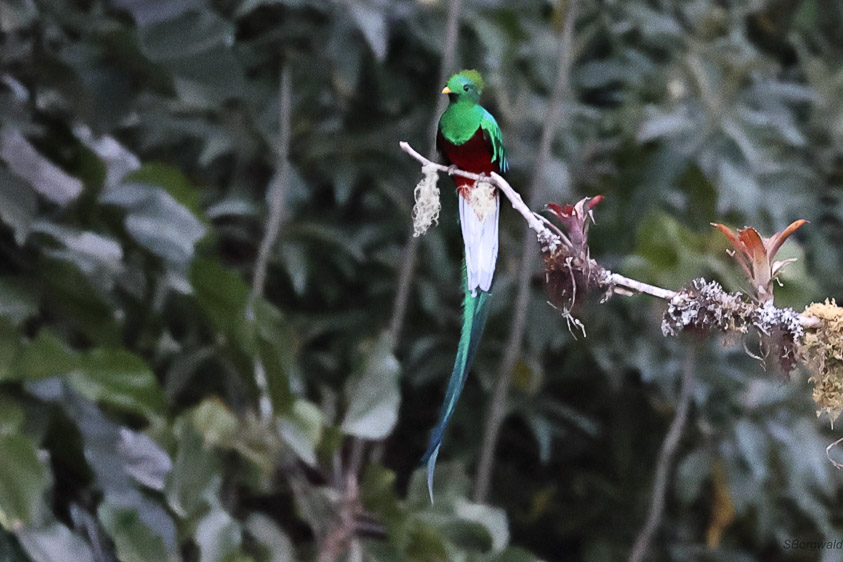 The stunning Resplendent Quetzal was probably the highlight of the trip (photo by tour participant Steve Borgwald).
The stunning Resplendent Quetzal was probably the highlight of the trip (photo by tour participant Steve Borgwald).
Overview
It was a real pleasure to have the chance to return to Costa Rica to lead our first Neotropical tour of 2022. Due to the interests of the participants on this Costa Rica Escape tour, we focused our attention on photography, primarily of birds, but also other wildlife, including as many vertebrates and invertebrates as we could find during our seven days as we explored some of the best birding hotspots of the country.
After a week of easy-paced and relaxed birding we managed to record 220 species of birds, including the most-wanted Resplendent Quetzal, and many other iconic species such as Scarlet Macaw, Great Green Macaw, Keel-billed Toucan, Yellow-throated Toucan, Prong-billed Barbet, American Dipper, Snowy Cotinga, King Vulture, Crested and Spectacled Owls, Great Curassow, and the elusive Tiny Hawk. We got almost all of the range-restricted near-endemics found in Costa Rica and western Panama only (known as Chiriqui endemics), such as Spangle-cheeked Tanager, Golden-browed Chlorophonia, Black-cheeked Warbler, Flame-throated Warbler, Collared Whitestart, Volcano Junco, and Yellow-thighed Brushfinch.
One of the tour highlights, and perhaps one of the most memorable experiences for the participants, was the incredible diversity of hummingbirds seen and being able to watch them at such close range! With 26 species seen, participants got a nice introduction to Neotropical hummingbirds, without being too overwhelmed. Thanks to the excellent feeding stations and blooming gardens we were able to observe hummingbirds at close range to determine sex, age, and any different plumage variations, resulting in some excellent learning opportunities. We were rewarded with so many treats, but the Black-crested Coquette, Violet Sabrewing, Black-bellied Hummingbird, and the endemic Coppery-headed Emerald ranked among the favorites.
We had a really fantastic Costa Rica tour, soaking in the rich wealth of natural history on offer while taking in the breathtaking landscapes and enjoying the beautiful lodges and great food.
Detailed Report
The group met at the beautiful and comfortable Bougainvillea Hotel in the Heredia district, just outside San Jose city. After introductions and welcomes we had a little time to walk around the gardens before dark and got fantastic views of a roosting Mottled Owl that was hiding in a clump of bamboo. What a great way to start the tour – everyone loves a good quality owl sighting! We enjoyed our welcome dinner as a group in the hotel restaurant, and we went to bed full of excitement with the promise of plenty of amazing birds and wildlife over the coming days.
The first day of the tour started with a couple of hours birding in the hotel grounds before breakfast and we got great views of typical species such Hoffmann’s Woodpecker, Brown Jay, Rufous-backed Wren, Baltimore Oriole, Blue-grey Tanager, Great Kiskadee, Clay-colored Thrush, Rufous-tailed Hummingbird, White-winged Dove, Cinnamon-bellied Saltator, our first encounter with Lesson’s Motmot, the handsome Chestnut-capped Warbler, and we managed to get decent views of Finsch’s Parakeet. We also found one of the few Summer Tanagers we encountered on the trip, in addition to American Yellow Warbler, Rufous-collared Sparrow, Great-tailed Grackle, Rufous-browed Peppershrike, and Yellow-headed Caracara. Sadly, the White-eared Ground Sparrow didn’t play ball for us this time. After breakfast, we met our driver Luis, and we left the hotel heading towards the northern Caribbean foothills. We made a stop at the well-known Freddo Fresas to look for our first hummingbird species and were rewarded with views of the splendid Violet Sabrewing, Purple-throated Mountaingem, Lesser Violetear, and Talamanca Hummingbird. We added more Blue-grey Tanagers, and Baltimore Orioles, and Melissa saw the first Wilson’s Warbler of the trip.
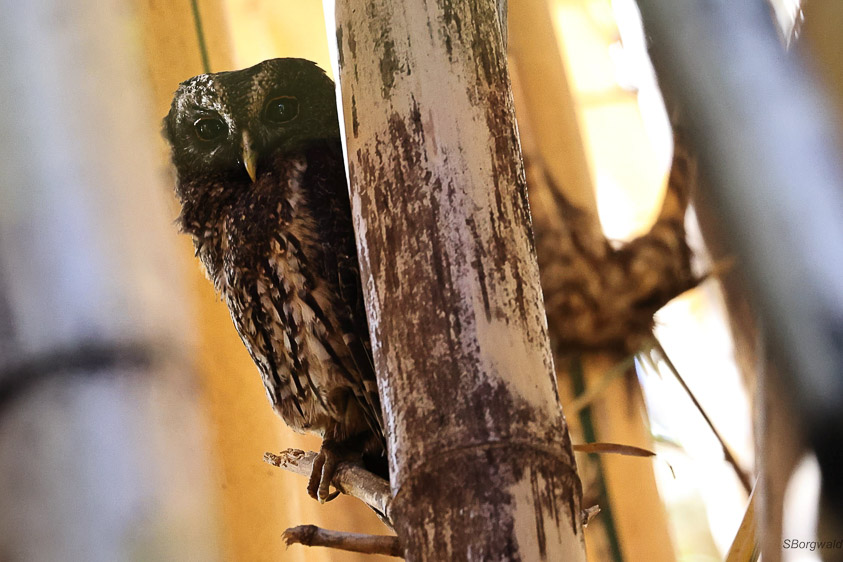
We continued our first day by visiting La Paz Waterfalls where we managed to add even more birds to our day, such as Ochraceous Wren, Tennessee Warbler, Common Bush Tanager, Slate-throated Whitestart, and had great views of Slaty-backed Nightingale-Thrush. We were surprised by the absence of hummingbird feeders at the site, feeders have been at this site for over 20 years, but they have recently been removed. However, many of the hummers were still around, and we managed to enjoy views of Green-crowned Brilliants (mostly females), Green Hermit, Violet Sabrewing, and the endemic Coppery-headed Emerald. We had lunch at La Paz, and we were amused by the presence of the Slaty-backed Nightingale-Thrush coming to our table trying to steal our food! However, we didn’t see the Large-footed Finches which we have seen here in previous years.
We left La Paz and headed to the Cinchona Restaurant feeders where we had a fantastic session with a plethora of striking and colorful species visiting the feeders, making this place an important stop on our tour. We found the awesome Blue-throated Toucanet, which was followed by Red-headed Barbet, Prong-billed Barbet, Silver-throated Tanager, Scarlet-rumped Tanager, Crimson-collared Tanager, Palm Tanager, Bananaquit, Cinnamon-bellied Saltator – all at eye level, providing high quality views! The hummingbird feeders provided new birds such as Black-bellied Hummingbird and White-bellied Mountaingem (seen and photographed by a single client only).
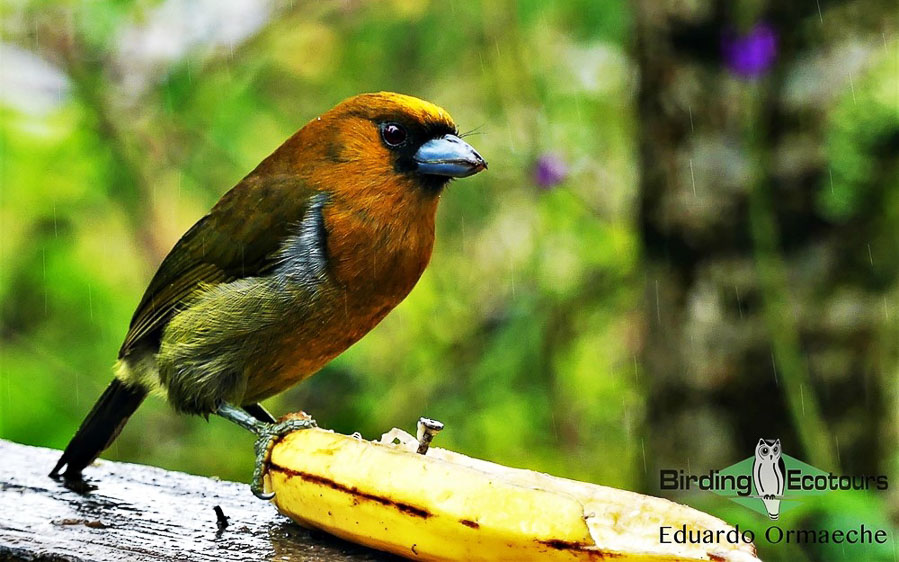
We left Cinchona and made a brief stop at Virgen del Socorro to explore the river in search of American Dipper, which was not around this time, and even though the activity was slow, we still managed to find Torrent Tyrannulet, Northern Tufted Flycatcher, Thick-billed Seed Finch, and Golden-olive Woodpecker
On the way to the Sarapiquí lowlands, we had great views of Yellow-throated Toucan perched by the side of the road, along with our first flock of Red-lored Amazons and Crested Guans. What an amazing first full day in Costa Rica!
For the second day of the tour, we planned to visit the Centro Manu, a new birding area for us which had recently produced multiple sightings of the most-wanted Bare-necked Umbrellabird, a bird we thought would be great to try and find. We knew that at this time of the year they move to higher elevations on an altitudinal migration, but as a few individuals were still recently seen in the area, we thought it was worth checking out. Once at the site activity was rather quiet and despite our best efforts, we could not get a sniff of this enigmatic bird. However, we did get plenty of other excellent birds that made our visit to the site worthwhile, such as close and eye-level views of Rufous-winged Woodpecker, Pale-billed Woodpecker, White-ruffed Manakin, Red-capped Manakin, Ruddy-tailed Flycatcher, Black-crowned Antshrike, Black-throated Trogon, Broad-billed Motmot, Cocoa Woodcreeper, Montezuma Oropendola, and Keel-billed Toucan. Some nice blooming bushes in a hummingbird garden attracted species such as Blue-chested Hummingbird, Black-crested Coquette, and Long-billed Hermit. Some interesting species such as Song Wren, Slaty-breasted Tinamou, and Northern Schiffornis were heard only.
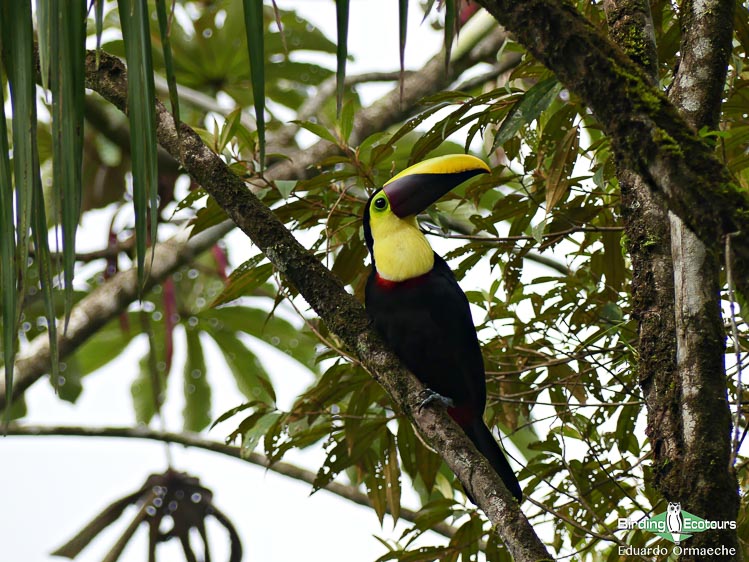
After a generous lunch, we went to visit “Donde Cope” which has become a classic and mandatory destination on this Costa Rica Escape tour, with all our bird- and wildlife-loving clients and friends ranking it as a great experience that is not to be missed!
We visited the feeders first and got great views of Collared Aracari, Yellow-throated Toucan, Montezuma and Chestnut-headed Oropendolas, and Orange-chinned Parakeet, followed by splendid views of Green Honeycreeper, several Red-legged Honeycreepers and a single Shining Honeycreeper. We also enjoyed Crimson-collared Tanager, Scarlet-rumped Tanager, Blue-grey Tanager, and Palm Tanager. In addition to this set of wonderful and colorful birds, we also saw Pale-vented Pigeon, Grey-cowled Wood Rail, and Red-winged Blackbirds. The hummingbird feeders here also provided our first White-necked Jacobin and Bronze-tailed Plumeleteer of the tour.
After some time at the feeders, we met Cope and he took us through the forest and across some fincas (farms), where we had a lot of fun with him and his extroverted personality. He took us to roosting trees for the sought-after and spectacular Crested Owl and we were lucky to get a pair at eye-level not far from us, and shortly after that, at another location we got a pair Spectacled Owls too. Two incredible owl species in the bag! The biggest surprise was a view of the shy Tiny Hawk, which provided great scope views. Other birds in the vicinity included Tropical Mockingbird and Yellow Tyrannulet. In addition to the birds, we got lots of classic creatures expected in the local area, such Honduran White Bat, Strawberry Poison (Dart) Frog, and Smooth Helmeted Iguana. We said goodbye to Cope, and before the end of the day we headed to Puerto Viejo, where we had the fortune of seeing a couple of pairs of the magnificent and rare Great Green Macaws going to roost, this was the cherry on top of another great day’s birding in Costa Rica.
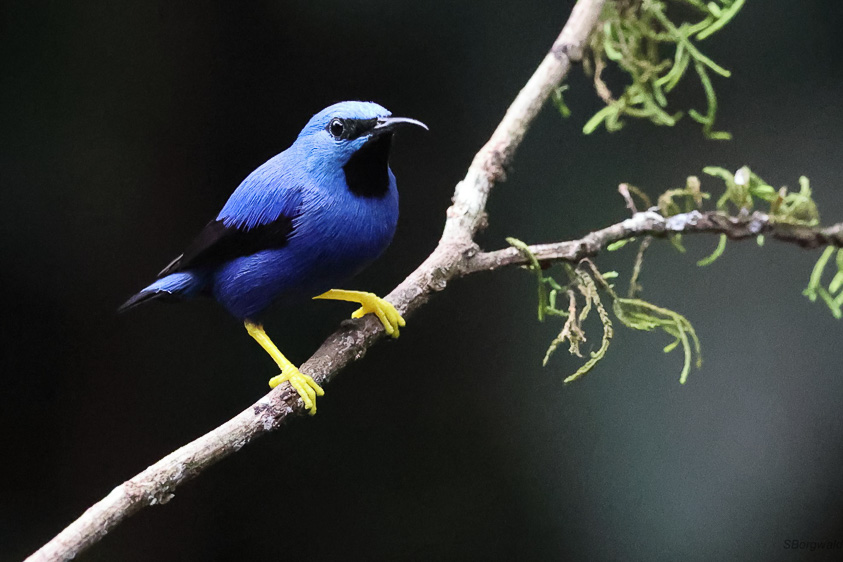
The following day we went to explore the famous La Selva Biological Station, spending a couple of sessions (one in the morning and another in the afternoon) birding this amazing site. The morning around the parking lot was productive, with quite of few Great Green Macaws flying over and even perching, something you do not see often! We quickly spotted a male Snowy Cotinga, one of the big targets of this location. We also got Short-billed Pigeon, Black-cheeked Woodpecker, Golden-hooded Tanager, Black-cowled Oriole, Chestnut-sided Warbler, Masked Tityra, Boat-billed Flycatcher, and Grey-rumped Swift. Melissa managed to photograph some White-crowned Parrots flying over. Later on the trails, we got more good species, such as Rufous-tailed Jacamar, Slaty-tailed Trogon, Gartered Trogon, Squirrel Cuckoo, Cinnamon Becard, Black-faced Grosbeak, Red-crowned Ant Tanager, Cinnamon Becard, Streak-headed Woodcreeper, Buff-throated Saltator, and Bay-headed Tanager. Another highlight was a close-up encounter with the stunning Chestnut-colored Woodpecker. From the suspension bridge, we saw Bare-throated Tiger Heron, Green Kingfisher, and Buff-rumped Warbler. We also had fun with the wildlife at La Selva, enjoying great views of Brown-throated Sloth, Geoffroy’s (Central American) Spider Monkey, and Common Green Iguana.
The afternoon was quieter than the morning, as usual, but we still got some good birds such as White-tipped Dove, Broad-winged Hawk, Rufous-winged Woodpecker, White-collared Manakin, Black-crowned Tityra, Olive-backed Euphonia, Scarlet-rumped Cacique, and great views of two female Great Curassows. We spent some time looking for the yellow morph of the Eyelash (Pit) Viper, which is often seen at La Selva, and we managed to find one after some time looking for it.
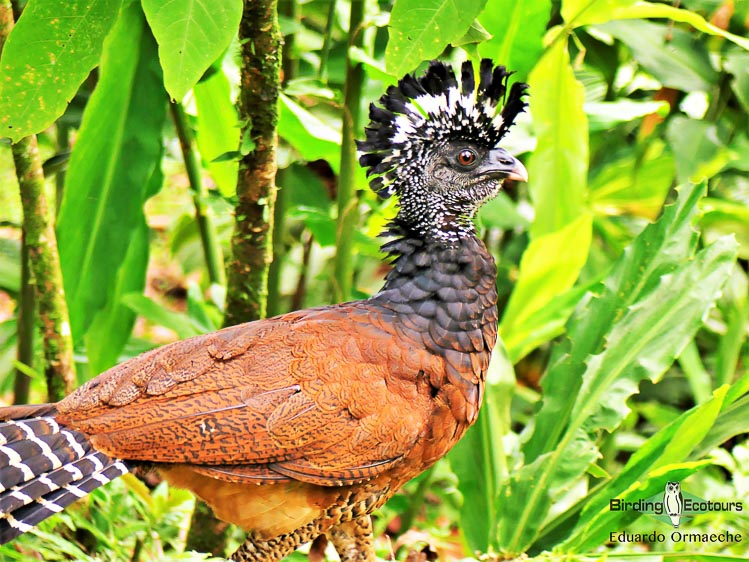
The following morning, we left La Quinta Inn after breakfast, but not before getting good views of Grey-headed Chachalaca, Red-throated Ant Tanager, and a Wood Thrush at the lodge feeders, with a Northern Waterthrush along the stream in front of the lodge entrance. We returned to Puerto Viejo where we got more views Great Green Macaw once again, but too distant to improve photo quality. We enjoyed a male Long-tailed Tyrant, and we spent some time trying to get a full view of Slaty Spinetail – a tough skulker! Other birds in the area included Morelet’s Seedeater, Grey Hawk, Black-cheeked Woodpecker, Variable Seedeater, and Ruddy Ground Dove. We then visited Puerto de Sarapiquí, where we managed to get a couple of nice surprises, including Scarlet Macaw (a bird we usually see in the Pacific lowlands rather than the Caribbean lowlands), followed by a King Vulture soaring among typical Black and Turkey Vultures. Other birds included a glimpse of Wedge-billed Woodcreeper, along with Prothonotary Warbler, Buff-rumped Warbler, Mangrove Warbler, Green Kingfisher, Southern Rough-winged Swallow and Grey-breasted Martin.
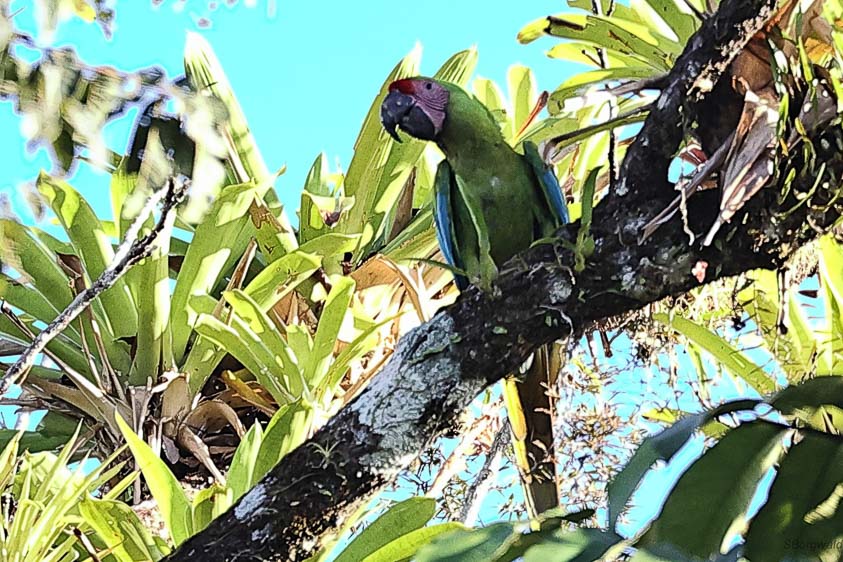
After some fun at Puerto de Sarapiquí we returned to the van, and headed to El Tapir (ex-Butterfly house) and found an unfortunate surprise that the place is now closed to visitors, a great shame. We spent a couple of minutes here before moving on, enough to add some new birds to the trip list, such as Violet-headed Hummingbird, a female Crowned Woodnymph, and a male Green Thorntail. There was, unfortunately, no sign of the Snowcap here. On the way to our restaurant for lunch we stopped along the road as we had a very nice Laughing Falcon perched nearby, with great light for photo opportunities. After lunch, we drove into the mountains and directly to San Gerardo de Dota in the Cordillera de Salamanca, to stay at the comfortable Savegre Lodge for three nights.
We enjoyed the change in habitat and also enjoyed the break from the heat and humidity of the Caribbean foothills while in the highly biodiverse montane forests of this mountain range. Staying at Savegre allowed us to explore all of the main birding hotspots in the surroundings. Before we even left the lodge for our morning excursion, we got nice views of Flame-colored Tanager, Long-tailed Silky-flycatcher, Slaty Flowerpiercer, Rufous-collared Sparrow, and Blue-and-white Swallow.
We drove up to the Cerro de Las Antenas (Antenna Hill) in the peak of the Cerro de la Muerte (Death Hill). Here at over 9,840 feet (3,000 meters), the maximum elevation reached on this tour, we looked for two special birds, Volcano Junco and Timberline Wren. We managed to get good views of both highly sought-after species. During the drive up I got a glimpse of a flock of Barred Parakeets, sadly, they did not stop for everyone to see, which is typical behaviour of this tough-to-catch-up-with species. In addition, we found Large-footed Finch, Ruddy-capped Nightingale-Thrush, a single Band-tailed Pigeon, several Volcano Hummingbirds, and had great views of Red-tailed Hawk. After scoring these target birds, we started to descend into the Pacific slope to visit the Bosque de Tolomuco Bed and Breakfast and Reserve. It was a shame to know that they will be closing at the end of March 2022, as we have enjoyed the hospitality of the owners and the great birds that this beautiful spot has to offer over multiple years on our birding tours to Costa Rica.
Here we got a load of new species for the trip, such as White-tailed Emerald, Snowy-bellied Hummingbird, a female Magenta-throated Woodstar, Red-headed Barbet, Red-crowned Woodpecker, Mistletoe Tyrannulet, White-naped Brushfinch, Isthmian Wren, Red-faced Spinetail, Cape May Warbler, Wilson’s Warbler, Scarlet-rumped Tanager (of the pacific race), Yellow-throated Vireo, and the striking Speckled Tanager. We also enjoyed Swallow-tailed Kites flying above the lodge. Sadly, the most-wanted White-crested Coquette did not show up this time.
In the afternoon, we visited Paraiso Los Quetzales Lodge to enjoy the feeders, and even though they were crowded, we got excellent views of Fiery-throated Hummingbird, Grey-tailed Mountaingem, several female Volcano Hummingbirds, and Talamanca Hummingbirds, along with a Mountain Thrush. Before it got dark, we explored the surroundings and we got good views of Black-capped Flycatcher. On the way to the lodge, we tried for Dusky Nightjar, getting the silhouette of two birds flying and calling above the road.
A new day dawned, and it was an important day full of expectations as we planned to look for one of the most-wanted birds in the Neotropics, Resplendent Quetzal. This year we planned to visit a different location rather than the classic “Vuelta Del Gato” by the public road and we took the group to a private property where we were told they were showing daily at close range, important factors for the photography aspects of this group. We had a predawn start and made the short drive to the site. The owner showed up at dawn and pointed out the quetzal’s favorite perch and in no time at all the adult male flew in and started showing really well, right in front of us! It came, and went a few times allowing us great views, we also enjoyed some flyby views, with the bird displaying its remarkable tail. Victory, and a very happy group!
We returned to the lodge for breakfast and to start our hike up to Los Robles, the forest above the lodge. We took a 4×4 jeep provided by the lodge up the hill and returned by hiking down the hill. The hike was great, providing many endemic birds of the Cordillera de Talamanca such as Spangle-cheeked Tanager, Black-cheeked Warbler, Flame-throated Warbler, Collared Whitestart, Yellow-thighed Brushfinch, Yellow-winged Vireo, Ruddy Treerunner, Yellowish Flycatcher, Spot-crowned Woodcreeper, the gorgeous male Golden-browed Chlorophonia, plus Black-throated Green Warbler, Philadelphia Vireo, Black-and-white Warbler, Sooty-capped Bush Tanager, Rufous-browed Peppershrike, and Mountain Elaenia. We heard Black-faced Solitaire, but we could not find it in the forest. Once we got back to the lodge, we found a covey of Spotted Wood Quails. It was incredible to see these birds just in front of our cabins providing excellent views of both males and females. The afternoon was free for everyone to do as they pleased, to provide some time for relaxing and time for participants to do their own thing at their own pace – take photos around the garden, work on photos, etc.
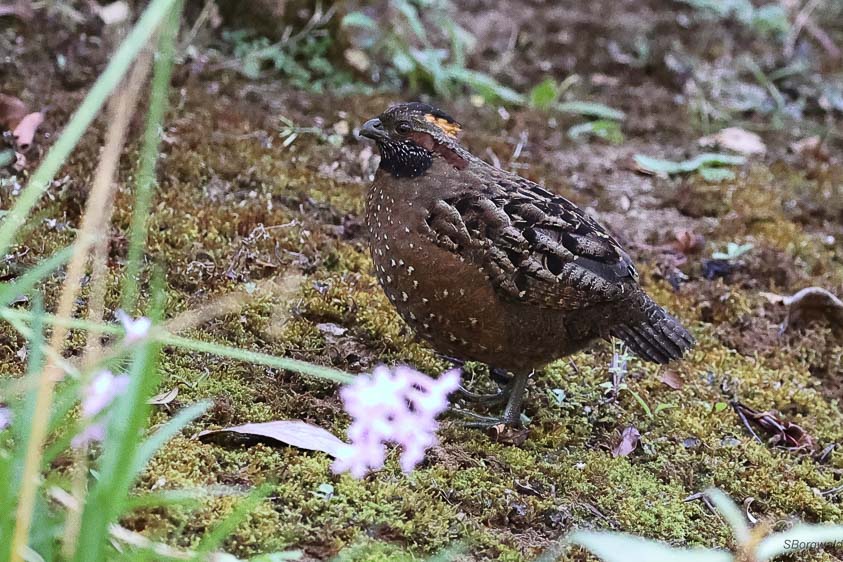
For the last day of the tour, we decided to walk around Savegre Lodge grounds, to pick up some birds we had missed on previous days. We started the day with Sulphur-winged Parakeet flying above the lodge, we actually had scope views of these on previous days, but one never tires of seeing parakeets. We also saw Western Osprey and Red-tailed Hawk. The great surprise came with views of a pair American Dippers on the river at the entrance to the lodge. Thanks to Luis who did well to spot this species. We did some birding along the roadside and found Stripe-tailed Hummingbird and another Resplendent Quetzal, it was amazing to find a male without looking for it or waiting for it – just pure luck. Other birds included Brown-capped Vireo, Mountain Elaenia, Yellow-winged Vireo, Slaty Flowerpiercer, Long-tailed Silky-flycatcher, Acorn Woodpecker, and a glimpse of Black-faced Solitaire (better than the heard only from the previous day, just!). We returned to the lodge where we had views of more Stripe-tailed Hummingbirds and Scintillant Hummingbirds.
We left the lodge, and we made our final birding stop at Miriam Restaurant, where we added close-up views of Acorn Woodpeckers, a female Golden-browed Chlorophonia, Sooty Thrush, and a single Melodious Blackbird. After this, we started the drive back to our hotel in San Jose where we sorted out our necessary Covid tests, ready for an early departure the following morning.
It was an amazing trip, with a great selection of tropical species, North America migrants, range-restricted endemics, and iconic wildlife, which was particularly enjoyable for those visiting the Neotropics for the first time, and also for those who have visited many times before!
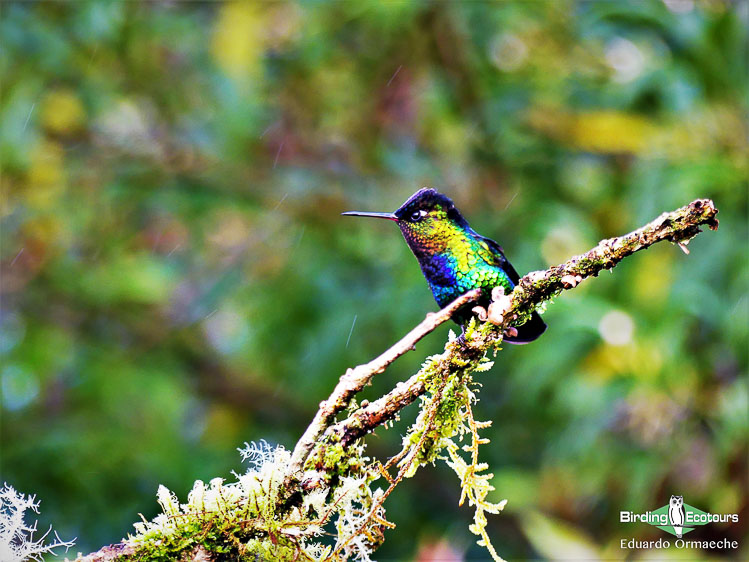
SYSTEMATIC BIRD LIST (IOC 12.1)
Tinamidae
Slaty-breasted Tinamou (H) Crypturellus boucardi This species was heard only at Centro Manu in the Caribbean foothills of costaricensis race, ranging from eastern Honduras to Costa Rica. Always secretive and hard to see.
Cracidae
Crested Guan Penelope purpurascens Great views of four individuals (of the aequatorialis race) along the road on the way to Sarapiquí.
Grey-headed Chachalaca Ortalis cinereiceps Good views at the Hotel La Quinta de Sarapiquí feeders.
Great Curassow Crax rubra Two females (of the nominate race) were seen nicely at La Selva Biological Station.
Odontophoridae
Spotted Wood Quail Odontophorus guttatus Amazing views of a family covey around our cabins in Savegre Lodge. It was great to see the males displaying their crests.
Caprimulgidae
Dusky Nightjar (H) Antrostomus saturatus Just the silhouettes of two birds flying and calling above the road near Savegre Lodge. Strictly nocturnal, and easily detected by voice. Restricted to the Talamanca Cordilleras and endemic to Costa Rica and western Panama.
Apodidae
White-collared Swift Streptoprocne zonaris Seen at several locations such as above Savegre Lodge, where we got the best views. It is the largest species of swift in its range except in southwestern Mexico, where it may co-exist with its slightly larger cousin, the White-naped Swift, which is one of the two largest swifts in the world.
Vaux’s Swift Chaetura vauxi A few (of the richmondi race) were seen at La Paz Waterfall Gardens.
Grey-rumped Swift Chaetura cinereiventris Seen in Puerto Viejo while looking for birds on the Sarapiquí River.
Trochilidae
White-necked Jacobin Florisuga mellivora Unmistakable males were a delight to see at the Cope feeders where we also had views of a few females as well.
Stripe-throated Hermit Phaethornis striigularis Good views in the garden of Cope. Here, of the saturates race.
Green Hermit Phaethornis guy The coruscus race was seen at La Paz Waterfalls and at Cope.
Long-billed Hermit Phaethornis longirostris Seen at Centro Manu. Here of the race cephalus.
Lesser Violetear Colibri cyanotus Seen at several locations including Freddo Fresas and Savegre. This is the near-endemic race cabanidis, found only in Costa Rica and Panama. This species and the Mexican Violetear were formerly considered conspecific and called ‘Green Violetear’.
Green Thorntail Discosura conversii Nice views of a male during our short visit to the hummingbird garden near the Braulio Carrillo National Park.
Black-crested Coquette Lophornis helenae We saw our first male in the Centro Manu and then another in the hummingbird gardens.
Green-crowned Brilliant Heliodoxa jacula Good views at La Paz Waterfalls, Cinchona and Cope where we saw mostly females. This is the near-endemic race henryi found in Costa Rica and Panama.
Talamanca Hummingbird Eugenes spectabilis Great views in the highlands of Costa Rica at several hummingbird feeders. This species is a split of Magnificent Hummingbird Eugenes fulgens. Talamanca Hummingbird now occurs in the mountains of Costa Rica and Panama and Rivoli’s Hummingbird Eugenes fulgens occurs from extreme southwestern USA to northern Nicaragua.
Fiery-throated Hummingbird Panterpe insignis Great views at Paraiso Los Quetzales Lodge. Found only in Costa Rica and western Panama.
Grey-tailed Mountaingem Lampornis cinereicauda We got good views of this species at Savegre and Paraiso los Quetzales Lodge. IOC recognize this species split from White-throated Mountaingem Lampornis castaneoventris treating Grey-tailed as a Costa Rica endemic and the White-throated as a Panama endemic, while Clements and Cornell treat both as conspecific.
Purple-throated Mountaingem Lampornis calolaemus Good views of a male at Freddo Fresas and a female at La Paz Waterfalls.
Magenta-throated Woodstar Calliphlox bryantae Only a female was seen at Bosque de Tolomuco. A near-endemic found in Costa Rica and Panama.
Volcano Hummingbird Selasphorus flammula Good views at Paraiso Los Quetzales Lodge where we saw mostly females. A few individuals were noted at the top of the hills near the antennas while looking for Volcano Junco. The individuals in the Talamanca Cordillera belong to the race torridus. This species is found in Costa Rica and Panama only.
Scintillant Hummingbird Selasphorus scintilla Seen in the Savegre gardens where Melissa managed to photograph the male. Found in Costa Rica and western Panama.
Violet-headed Hummingbird Klais guimeti Seen at the hummingbird garden near the Braulio Carrillo National Park. This is the race merrittii,
Violet Sabrewing Campylopterus hemileucurus Great views of this spectacular male at several locations including Cinchona, La Paz and Bosque de Tolomuco. The female was seen at Freddo Fresas.
Bronze-tailed Plumeleteer Chalybura urochrysia Great views of the melanorrhoa race at Cope.
Crowned Woodnymph Thalurania colombica A female was seen at Cope and another in the hummingbird gardens near the Braulio Carrillo National Park.
Coppery-headed Emerald Microchera cupreiceps One of the few Costa Rica endemics. We got our first encounter at La Paz Waterfalls and then great views at the Cinchona feeders.
White-tailed Emerald Microchera chionura Great views at Bosque de Tolomuco. Found in Costa Rica and Panama.
Stripe-tailed Hummingbird Eupherusa eximia The egregia race was seen around Savegre Lodge gardens.
Black-bellied Hummingbird Eupherusa nigriventris Great views of a male at the Cinchona feeders.
Snowy-bellied Hummingbird Saucerottia edward Great views of the niveoventer race at Bosque de Tolomuco. Found in southwestern Costa Rica and Panama only.
Rufous-tailed Hummingbird Amazilia tzacatl One of the most common hummingbirds in the country. We had several encounters with this widespread species. This is the nominate race.
Blue-chested Hummingbird Polyerata amabilis Seen at Centro Manu.
Cuculidae
Groove-billed Ani Crotophaga sulcirostris A few sightings during our drives in the north and at Cope.
Squirrel Cuckoo Piaya cayana Seen at Hotel Bouganvillea and at La Selva Biological Station. This is the race thermophila.
Columbidae
Rock Dove (Feral Pigeon) Columba livia dom. Common in towns.
Band-tailed Pigeon Patagioenas fasciata Seen above Savegre Lodge.
Red-billed Pigeon Patagioenas flavirostris Seen at the Bougainvillea Hotel.
Pale-vented Pigeon Patagioenas cayennensis Seen at Cope. Here of the race pallidicrissa.
Short-billed Pigeon Patagioenas nigrirostris Seen at La Selva Biological Station.
Ruddy Ground Dove Columbina talpacoti Seen along the Puerto Viejo Road.
White-tipped Dove Leptotila verreauxi Seen at La Selva Biological Station. Here of the nominate race.
White-winged Dove Zenaida asiatica Seen around San Jose.
Rallidae
Grey-cowled Wood Rail Aramides cajaneus Great views at Cope
Threskiornithidae
Green Ibis Mesembrinibis cayennensis One bird was flushed at La Selva while the group was trying to photograph Black-faced Grosbeak.
Ardeidae
Bare-throated Tiger-Heron Tigrisoma mexicanum One adult seen nicely at La Selva.
Green Heron Butorides virescens One individual seen flying by during our drive from Sarapiquí to La Selva.
Western Cattle Egret Bubulcus ibis A few seen along the agricultural pastures. IOC recognize Western Cattle Egret Bubulcus ibis as a split from Cattle Egret occurring in Europe, Africa, Middle East and the Americas and Eastern Cattle Egret Bubulcus coromandus occurring in Asia and Australia most other authorities do not recognize this split.
Great Egret Ardea alba A few sightings along fields. Clements use the English name Great White Egret Ardea alba.
Snowy Egret Egretta thula A few individuals were seen during one of our drives.
Cathartidae
King Vulture Sarcoramphus papa Great encounters with one bird soaring above Puerto Viejo.
Black Vulture Coragyps atratus Common throughout the trip. It is also known as American Black Vulture.
Turkey Vulture Cathartes aura Common throughout the trip.
Pandionidae
Western Osprey Pandion haliaetus Seen flying above Savegre. The IOC recognize this species as a split of Osprey Pandion haliaetus into two separate species Western Osprey occurring in most of the world and Eastern Osprey Pandion cristatus occurring in Australia and Sulawesi. Other authorities don’t recognize this split.
Accipitridae
Swallow-tailed Kite Elanoides forficatus Great views above Bosque de Tolomuco.
Tiny Hawk Accipiter superciliosus A great encounter with this seldom-seen raptor not far from Cope.
Grey Hawk Buteo plagiatus Few encounters with species during the trip including a couple displaying in Puerto Viejo. This species occurs from North America to northern Costa Rica with a split Grey-lined Hawk Buteo nitidus occurring from southern Costa Rica to northern Argentina. Split Grey-lined Hawk (B. nitidus) and Grey Hawk (B. plagiatus) (Sibley & Monroe 1993; Millsap et al. 2011; NACC 2011-A-4).
Broad-winged Hawk Buteo platypterus Two encounters with this species, first at La Selva and then driving up Cerro de La Muerte.
Red-tailed Hawk Buteo jamaicensis Nice views of this raptor soaring above Savegre and Los Quetzales National Park. This being the costaricensis race endemic to Costa Rica and Panama.
Strigidae
Spectacled Owl Pulsatrix perspicillata Excellent views in the forest near Cope.
Crested Owl Lophostrix cristata Great views of a pair at a daytime roost in the forest near Cope.
Mottled Owl Strix virgata An individual roosting during the daytime at Hotel Bouganvillea. This being the centralis race.
Trogonidae
Resplendent Quetzal Pharomachrus mocinno We had good luck on this trip with two amazing sightings. The first a male at Unicorn Lodge and then a second male during our walk to the waterfalls near Savegre Lodge. This being the near-endemic race costaricensis. The name quetzal is from Nahuatl quetzalli [keˈt͡salːi], “large brilliant tail feather” (American Audubon Dictionary) or “tail coverts of the quetzal” (Merriam-Webster’s Collegiate Dictionary), from the Nahuatl root quetz = “stand up” used to refer to an upright plume of feathers. The word entered English through Spanish.
The word quetzal was originally used for just the Resplendent Quetzal, the Long-tailed Quetzal of Guatemala, (more specifically the area of Northern Guatemala known as the Petén) which is the national bird and the name of the currency of Guatemala.
Until recently, it was thought that the Resplendent Quetzal could not be bred or held for any period of time in captivity, and indeed it was noted for usually dying soon after being captured or caged. For this reason, it is a traditional symbol of liberty. However, the Miguel Álvarez Del Toro Zoo in Tuxtla Mexico has kept this species since 1992, and in 2004 breeding in captivity was announced. A chick hatched and reached the age of six weeks at the time of the report.
Slaty-tailed Trogon Trogon massena Seen at La Selva Biological Station. Here of the near-endemic race hoffmanni.
Black-throated Trogon Trogon rufus Seen at Centro Manu. Here of the race tenellus.
Gartered Trogon Trogon caligatus Seen at La Selva Biological Station.
Alcedinidae
Green Kingfisher Chloroceryle americana Seen at La Selva and in the Sarapiquí River. Here of the race septentrionalis.
Momotidae
Lesson’s Motmot Momotus lessonii Seen in Hotel Bouganvillea gardens. Here of the nominate race.
Broad-billed Motmot Electron platyrhynchum Seen at Centro Manu. Here of the race minus.
Galbulidae
Rufous-tailed Jacamar Galbula ruficauda Seen at La Selva Biological Station. Here of the race melanogenia..
Capitonidae
Red-headed Barbet Eubucco bourcierii Great views at Cinchona feeders with a female seen at Bosque de Tolomuco.
Semnornithidae
Prong-billed Barbet Semnornis frantzii Great views at Cinchona feeders. A near-endemic found in Costa Rica and Panama only. This family contains only two species the Prong-billed Barbet from Costa Rica and Panama and the Toucan Barbet Semnornis ramphastinus from western Colombia and Panama.
Ramphastidae
Blue-throated Toucanet Aulacorhynchus caeruleogularis Great views at Cinchona feeders. IOC considers this species as a split from Emerald Toucanet, with Blue-throated Toucanet occurring from Costa Rica to northwestern Colombia while other authorities (including Clements) consider it as Northern Emerald Toucanet Aulacorhynchus prasinus.
Collared Aracari Pteroglossus torquatus Close-up views at Cope and La Selva Biological Station.
Keel-billed Toucan Ramphastos sulfuratus Splendid views at Centro Manu. The national bird of Belize.
Yellow-throated Toucan Ramphastos ambiguus The most frequently encountered toucan in the Caribbean foothills.
Picidae
Acorn Woodpecker Melanerpes formicivorus Seen at Savegre Lodge with plenty individuals at Miriam’s Restaurant feeders. Here of the race striatipectus from Nicaragua to western Panama.
Black-cheeked Woodpecker Melanerpes pucherani Great views at La Selva Biological Station.
Red-crowned Woodpecker Melanerpes rubricapillus Seen at Bosque de Tolomuco.
Hoffmann’s Woodpecker Melanerpes hoffmannii Seen at Hotel Bougainvillea. Named after Karl Hoffmann, a 19th century German physician and naturalist living in Costa Rica.
Rufous-winged Woodpecker Piculus simplex Great views at both Centro Manu and La Selva Biological Station.
Golden-olive Woodpecker Colaptes rubiginosus Seen at Virgen del Socorro. Here of the race yucatanensis.
Chestnut-colored Woodpecker Celeus castaneus Great views at La Selva Biological Station.
Pale-billed Woodpecker Campephilus guatemalensis Great views at Centro Manu.
Falconidae
Crested Caracara Caracara plancus A few seen in open country.
Yellow-headed Caracara Milvago chimachima A few seen flying above fields and along roads.
Laughing Falcon Herpetotheres cachinnans A great encounter with an individual along the main road near the hummingbird house. This Neotropical species is a specialist snake eater. Its common and scientific names both refer to its distinctive voice.
Collared Forest Falcon (H) Micrastur semitorquatus Heard only, before dusk while we were still birding in the Puerto Viejo fields. A crepuscular and secretive forest raptor.
Bat Falcon Falco rufigularis One encounter in the Puerto Viejo fields.
Psittacidae
Barred Parakeet Bolborhynchus lineola A flock of about 20 birds flying in classic tight formation were glimpsed very briefly on our way up to Cerro de La Muerte.
Orange-chinned Parakeet Brotogeris jugularis Close-up views of few individuals at the bird feeders at Cope.
Brown-hooded Parrot (H) Pyrilia haematotis Sadly heard only at La Selva Biological Station.
Red-lored Amazon Amazona autumnalis Several nice encounters with this species in the Caribbean foothills.
Sulphur-winged Parakeet Pyrrhura hoffmanni Seen daily flying above Savegre Lodge. We managed to get scope views of distant birds that showed their field marks well enough. Endemic to Costa Rica and western Panama.
Olive-throated Parakeet Eupsittula nana Two individuals were seen perched distantly against strong light in trees around the Puerto Viejo fields. On our photos we managed to see the field marks to confirm identification.
Great Green Macaw Ara ambiguus We have never saw as many Great Green Macaws on a single trip as on this trip. Several were seen flying by at La Selva Biological Station in an open clearing. We got our best views near Puerto Viejo. They are considered Critically Endangered (BirdLife International) with a population between 500-1,000 individuals.
Scarlet Macaw Ara macao Great views at Puerto Viejo. They are not as common in the Caribbean foothills as in the Pacific slope.
Finsch’s Parakeet Psittacara finschi Great views at Hotel Bouganvillea. They are also known as Crimson-fronted Parakeet. Named after Friedrich Hermann Otto Finsch, a 19th century German diplomat, ornithologist, collector, and author.
Furnariidae
Wedge-billed Woodcreeper Glyphorynchus spirurus One seen briefly at Puerto Sarapiquí. Here of the race pectoralis.
Cocoa Woodcreeper Xiphorhynchus susurrans Seen at Centro Manu.
Streak-headed Woodcreeper Lepidocolaptes souleyetii Seen at La Selva Biological Station.
Spot-crowned Woodcreeper Lepidocolaptes affinis Seen in the forest above Savegre Lodge.
Streaked Xenops Xenops rutilans Seen in the forest above Savegre Lodge.
Ruddy Treerunner Margarornis rubiginosus Great views above Savegre Lodge. Found in Costa Rica and western Panama only.
Red-faced Spinetail Cranioleuca erythrops Glimpses at Bosque de Tolomuco.
Slaty Spinetail Synallaxis brachyura Seen after some work, along the Puerto Viejo Road.
Thamnophilidae
Black-crowned Antshrike Thamnophilus atrinucha Seen at both Centro Manu and La Selva.
Chestnut-backed Antbird (H) Poliocrania exsul This species was heard only at La Selva.
Tyrannidae
Mountain Elaenia Elaenia frantzii Seen around Savegre Lodge.
Torrent Tyrannulet Serpophaga cinerea Seen at Virgen del Socorro.
Yellow Tyrannulet Capsiempis flaveola Seen in the fields at Cope and Puerto Viejo.
Mistletoe Tyrannulet Zimmerius parvus Seen at Freddo Fresas and at Bosque de Tolomuco. Formerly Paltry Tyrannulet vilissimus which was split into two different species Guatemalan Tyrannulet Zimmerius vilissimus from Mexico to western Guatemala and El Salvador and Mistletoe Tyrannulet Zimmerius parvus from northeast Guatemala to northwest Colombia.
Common Tody-Flycatcher Todirostrum cinereum Photographed by Melissa in the gardens of La Selva.
Northern Tufted Flycatcher Mitrephanes phaeocercus Nice views at Virgen del Socorro. Here of the race aurantiiventris.
Yellowish Flycatcher Empidonax flavescens Good views in the forest above Savegre Lodge.
Black-capped Flycatcher Empidonax atriceps Seen well at Cerro de La Muerte. Found in Panama and Costa Rica only.
Long-tailed Tyrant Colonia colonus Nice views of an adult male in the fields of Puerto Viejo.
Social Flycatcher Myiozetetes similis Common at several places.
Great Kiskadee Pitangus sulphuratus Common at several places.
Boat-billed Flycatcher Megarynchus pitangua One sighting in the gardens of La Selva Biological Station.
Tropical Kingbird Tyrannus melancholicus common at several places.
Cotingidae
Snowy Cotinga Carpodectes nitidus Scope views of a male in La Selva Biological Station.
Pipridae
White-ruffed Manakin Corapipo altera Great views at Centro Manu.
White-collared Manakin Manacus candei Seen in the gardens of La Selva Biological Station, where we got views of both sexes.
Red-capped Manakin Ceratopipra mentalis Great views at Centro Manu. Here of the nominate race.
Tityridae
Ruddy-tailed Flycatcher Terenotriccus erythrurus Seen well at Centro Manu.
Masked Tityra Tityra semifasciata Seen at La Selva. Widespread from Mexico to Argentina. Here of the race costaricensis.
Northern Schiffornis (H) Schiffornis veraepacis This was heard only at Centro Manu.
Barred Becard (H) Pachyramphus versicolor This was heard only in the forest above Savegre Lodge.
Cinnamon Becard Pachyramphus cinnamomeus Seen well at La Selva Biological Station.
Vireonidae
Rufous-browed Peppershrike Cyclarhis gujanensis Seen at Hotel Bouganvillea. Here of the race subflavescens.
Yellow-winged Vireo Vireo carmioli Seen well in the forest above Savegre Lodge. Found in Costa Rica and Panama only.
Brown-capped Vireo Vireo leucophrys Seen around Savegre Lodge. Only one sighting on the trip.
Philadelphia Vireo Vireo philadelphicus Seen at Hotel Bouganvillea.
Yellow-throated Vireo Vireo flavifrons Seen only by the leader at Bosque de Tolomuco.
Corvidae
Brown Jay Psilorhinus morio Seen at Hotel Bouganvillea and Bosque de Tolomuco.
Ptiliogonatidae
Long-tailed Silky-flycatcher Ptiliogonys caudatus Excellent views of this handsome species at Savegre Lodge.
Hirundinidae
Mangrove Swallow Tachycineta albilinea Good sightings along the Sarapiquí River.
Grey-breasted Martin Progne chalybea At least one bird was seen along the Sarapiquí River.
Blue-and-white Swallow Notiochelidon cyanoleuca Seen around Savegre Lodge.
Southern Rough-winged Swallow Stelgidopteryx ruficollis Seen along the Sarapiquí River.
Troglodytidae
Rufous-backed Wren Campylorhynchus capistratus IOC have renamed Rufous-naped Wren Campylorhynchus capistratus to Veracruz Wren Campylorhynchus rufinucha as an endemic from Veracruz, Mexico followed by two splits Sclater’s Wren Campylorhynchus humilis occurring in southwestern Mexico and Rufous-backed Wren Campylorhynchus capistratus from southwestern Mexico to Costa Rica. Clements considers them conspecific.
Stripe-breasted Wren Cantorchilus thoracicus We saw one skulking individual along the trails of La Selva Biological Station.
Isthmian Wren Cantorchilus elutus Glimpses of an uncooperative bird at Bosque de Tolomuco. This is a split from Plain Wren occurring from southwestern Costa Rica to western Panama.
House Wren Troglodytes aedon Seen in Puerto Viejo.
Ochraceous Wren Troglodytes ochraceus Good views at La Paz Waterfall. This is found only in Costa Rica and Panama.
Timberline Wren Thryorchilus browni We managed to see this species at its usual spot up on the Antenna Road above Cerro de La Muerte. Found in Costa Rica and Panama.
Grey-breasted Wood-Wren (H) Henicorhina leucophrys Heard only around Savegre.
Song Wren (H) Cyphorhinus phaeocephalus Only heard along the trails of Centro Manu.
Mimidae
Tropical Mockingbird Mimus gilvus One seen near Cope.
Turdidae
Black-faced Solitaire Myadestes melanops Seen around Savegre Lodge. Found in Costa Rica and Panama.
Slaty-backed Nightingale-Thrush Catharus fuscater Seen at La Paz Waterfalls including ridiculous views of one individual coming to the restaurant table for leftovers. Here of the race hellmayri.
Ruddy-capped Nightingale-Thrush Catharus frantzii Good views around Savegre and Cerro de La Muerte.
Wood Thrush Hylocichla mustelina One individual seen near the feeders at La Quinta Inn in Sarapiquí.
Sooty Thrush Turdus nigrescens Seen at Miriam’s Restaurant. Found in Costa Rica and Panama only.
Mountain Thrush Turdus plebejus Common around Savegre.
Clay-colored Thrush Turdus grayi the most encountered thrush and the national bird of Costa Rica.
Cinclidae
American Dipper Cinclus mexicanus Great views, thanks to our driver Luis, of one individual in the river in Savegre Lodge.
Passeridae
House Sparrow Passer domesticus Seen just about every time we stopped at a gas station to get fuel and use toilet facilities.
Fringillidae
Olive-backed Euphonia Euphonia gouldi Seen in the gardens at La Selva Biological Station.
Golden-browed Chlorophonia Chlorophonia callophrys Super bird! A male was seen in the canopy of the forest above Savegre Lodge and then we got a female at eye-level at the feeders of Miriam’s Restaurant. Found in Costa Rica and Panama only.
Passerellidae
Sooty-capped Bush Tanager Chlorospingus pileatus Great views at Savegre, Paraiso Los Quetzales Lodge, Miriam’s and Cerro de La Muerte. Found in Costa Rica and Panama only.
Common Bush Tanager Chlorospingus flavopectus We got our first at Freddo Fresas. Here of the race regionalis. A potential future split!
Orange-billed Sparrow (H) Arremon aurantiirostris Heard only at La Selva.
Volcano Junco Junco vulcani Great views at the top of the Antenna Road above El Cerro de La Muerte. Found only in Costa Rica and Panama.
Rufous-collared Sparrow Zonotrichia capensis Seen well at Freddo Fresas and around Savegre Lodge.
Large-footed Finch Pezopetes capitalis Great views above Savegre and Paraiso Los Quetzales Lodge. Found in Costa Rica and Panama.
White-naped Brushfinch Atlapetes albinucha Seen at Bosque de Tolomuco. Here of the endemic race parvirostris.
Yellow-thighed Brushfinch Atlapetes tibialis Nice views at Savegre Lodge. Found only in Costa Rica and Panama.
Icteridae
Chestnut-headed Oropendola Psarocolius wagleri Seen at Cope.
Montezuma Oropendola Psarocolius montezuma Common in the Caribbean foothills. We got our best views at Cope.
Scarlet-rumped Cacique Cacicus microrhynchus Only a single encounter at La Selva Biological Station.
Baltimore Oriole Icterus galbula Several seen throughout the trip.
Black-cowled Oriole Icterus prosthemelas Good views at La Selva Biological Station.
Red-winged Blackbird Agelaius phoeniceus Seen at Cope.
Melodious Blackbird Dives dives Seen at Miriam’s Restaurant.
Great-tailed Grackle Quiscalus mexicanus Common throughout.
Parulidae
Northern Waterthrush Parkesia noveboracensis Seen at La Quinta de Sarapiquí.
Golden-winged Warbler Vermivora chrysoptera A few encounters on the trip.
Black-and-white Warbler Mniotilta varia Two encounters on the trip only.
Prothonotary Warbler Protonotaria citrea Scope views of two birds along the Sarapiquí River.
Flame-throated Warbler Oreothlypis gutturalis Great views above Savegre Lodge. Found only in Costa Rica and Panama.
Tennessee Warbler Leiothlypis peregrina The most common migratory warbler of the trip.
Cape May Warbler Setophaga tigrina One sighting at Bosque de Tolomuco.
Blackburnian Warbler Setophaga fusca Seen at Hotel Bouganvillea.
Mangrove Warbler Setophaga petechia Seen along the Sarapiquí River.
American Yellow Warbler Setophaga aestiva Seen at Hotel Bouganvillea.
Chestnut-sided Warbler Setophaga pensylvanica Seen at La Selva Biological Station.
Black-throated Green Warbler Setophaga virens Seen above Savegre Lodge.
Buff-rumped Warbler Myiothlypis fulvicauda Seen at La Selva and along the Sarapiquí River.
Chestnut-capped Warbler Basileuterus rufifrons This handsome warbler was seen at Hotel Bouganvillea.
Black-cheeked Warbler Basileuterus melanogenys Seen at Paraiso Los Quetzales Lodge and around Savegre Lodge. Found only in Costa Rica and Panama.
Wilson’s Warbler Cardellina pusilla A few sightings at Freddo Fresas, Cinchona, La Selva and Tolomuco.
Slate-throated Whitestart Myioborus miniatus Seen at La Paz Waterfalls.
Collared Whitestart Myioborus torquatus This beautiful bird was seen very well above Savegre Lodge. Found only in Costa Rica and Panama.
Cardinalidae
Flame-colored Tanager Piranga bidentata Seen at Savegre Lodge and Miriam’s. Here of the race citrea.
Summer Tanager Piranga rubra Seen at Hotel Bouganvillea and Bosque de Tolomuco.
Red-crowned Ant Tanager Habia rubica Seen in the Caribbean foothills, particularly well at the feeders of La Quinta In Hotel.
Black-faced Grosbeak Caryothraustes poliogaster Seen at La Selva. Here of the race scapularis.
Thraupidae
Green Honeycreeper Chlorophanes spiza Best views at Cope. Here of the race argutus.
Red-legged Honeycreeper Cyanerpes cyaneus Plenty at Cope.
Shinning Honeycreeper Cyanerpes lucidus One individual seen at Cope.
Buff-throated Saltator Saltator maximus Seen at La Selva.
Cinnamon-bellied Saltator Saltator grandis Seen at Hotel Bougainvillea and at Cinchona feeders. Formerly Greyish Saltator which has been split into three different species: Blue-grey Saltator Saltator coerulescens from southern South America, Olivaceous Saltator Saltator olivascens from northern South America and Cinnamon-bellied Saltator found from Mexico to Panama.
Bananaquit Coereba flaveola Several sightings. A potential split! Here of the race mexicana.
Crimson-collared Tanager Ramphocelus sanguinolentus Nice views at Cinchona and Cope.
Scarlet-rumped Tanager Ramphocelus passerinii Several sightings of this species throughout the trip. The English name of R. passerinii has changed from Passerini’s Tanager to Scarlet-rumped Tanager, following the lumping of Cherrie’s Tanager R. p. costaricensis. We managed to get a view of the female in the bird feeders of Bosque de Tolomuco which shows bright orange on the chest.
Morelet’s Seedeater Sporophila morelleti Seen in the Puerto Viejo fields. Named after Pierre Marie Arthur Morelet, a 19th century French naturalist.
Variable Seedeater Sporophila corvina Seen around La Quinta Inn and at Virgen Del Socorro. Here of the nominate race.
Thick-billed Seed Finch Sporophila funerea Seen at Virgen del Socorro.
Slaty Flowerpiercer Diglossa plumbea Seen at Freddo Fresas and Savegre Lodge. Found in Costa Rica and Panama only.
Speckled Tanager Ixothraupis guttata Great views in the feeders of Bosque de Tolomuco. Here of the race eusticta.
Blue-grey Tanager Thraupis episcopus Nice views in the lowlands.
Palm Tanager Thraupis palmarum Seen in the lowlands.
Golden-hooded Tanager Stilpnia larvata Good views in the lowlands.
Spangle-cheeked Tanager Tangara dowii Seen well above Savegre Lodge. Found in Costa Rica and Panama only.
Bay-headed Tanager Tangara gyrola Seen in the gardens of La Selva Biological Station.
Silver-throated Tanager Tangara icterocephala Numerous at Cinchona and Bosque de Tolomuco. Here of the race frantzii.
MAMMALS
Bradypodidae
Brown-throated Sloth Bradypus variegatus Great views at La Selva.
Atelidae
Geoffroy’s (Central American) Spider Monkey Ateles geoffroyi An excellent encounter at La Selva.
Mantled Howler Monkey Alouatta palliata Seen at La Selva.
Cebidae
Panamanian White-faced Capuchin Cebus imitator Seen at Centro Manu.
Procyonidae
White-nosed Coati Nasua narica One seen at Bosque de Tolomuco.
Tayassuidae
Collared Peccary Dicotyles tajacu Seen at La Selva.
Sciuridae
Variegated Squirrel Sciurus variegatoides Seen on several occasions.
Red-tailed Squirrel Sciurus granatensis A few sightings on the trip.
Dasyproctidae
Central American Agouti Dasyprocta punctata Seen at La Selva.
Emballonuridae
Proboscis Bat Rhynchonycteris naso Seen roosting underneath some of the laboratory rooms rooves at La Selva Biological Station.
Phyllostomidae
Honduran White Bat Ectophylla alba Great views at Cope.
Tent-making Bat Uroderma bilobatum Good views at Cope.
REPTILES
Black Wood Turtle Rhinoclemmys funerea Seen from the bridge at La Selva.
Yellow-headed Gecko Gonatodes albogularis Only a female was seen at the entrance of Centro Manu.
Common House Gecko Hemidactylus frenatus Seen in Hotel La Quinta. Native from Southeast Asia.
Common Green Iguana Iguana iguana. Seen in the lowlands.
Smooth Helmeted Iguana Corytophanes cristatus Seen at Cope.
Bighead (Pug-nosed) Anole Anolis capito Seen at Cope.
Humble (Ground) Anole Anolis humilis Seen at La Selva.
Green Spiny Lizard Sceloporus malachiticus Also known as Emerald Swift. This high elevation lizard was seen around Savegre Lodge and above Cerro de La Muerte.
Eyelash (Pit) Viper Bothriechis schlegelii Awesome views of the yellow morph at La Selva.
AMPHIBIANS
Strawberry Poison (Dart) Frog Oophaga pumilio Also known as “The Blue Jeans Frog”. Nice views at Cope.
Red-eyed Treefrog Agalychmis callidryas We saw the Caribbean race in La Quinta Hotel. The national frog of Costa Rica!
This is a sample trip report. Please email us ([email protected]) for more trip reports from this destination.
